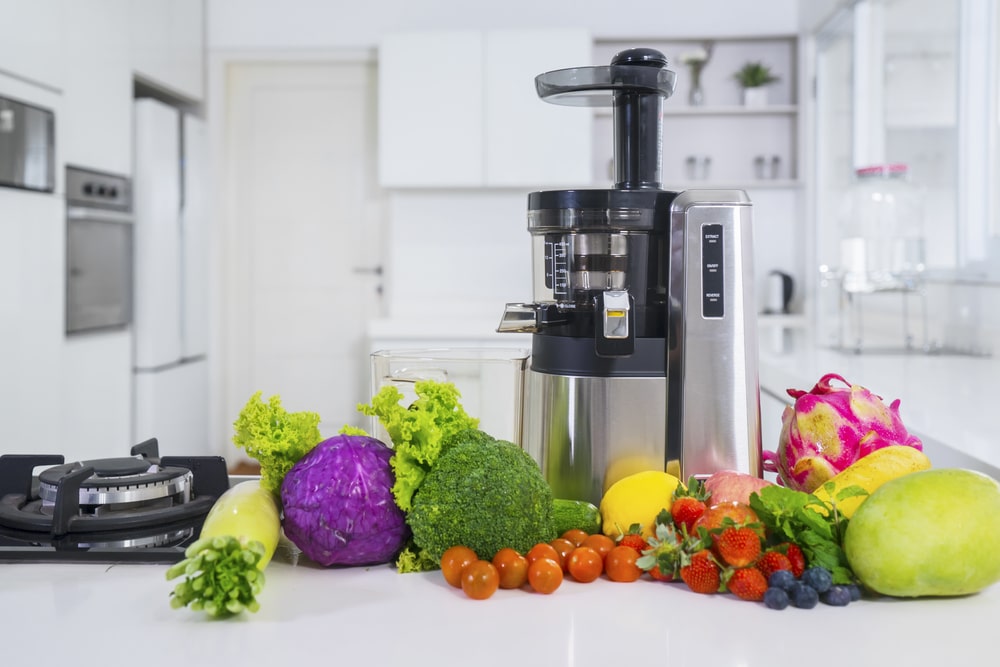Last Updated on January 10, 2023
There are several types of juicers available on the market today, the two most common being a centrifugal juicer and a masticating juicer. Most people are familiar with the type of juicer referred to as a centrifugal juicer because they are the most common for at-home use, but it is not unlikely that you have never heard of a masticating juicer. What is a masticating juicer? Are masticating juicers also called slow juicers? This article answers these questions and more by exploring the detailed traits associated with masticating juicers. We also feature a brief comparison of different types of juicers at the end so you can easily recognize the differences, pros, and cons, in direct relation to each other.
Masticating Juicers Explained
A masticating juicer is also known as a slow masticating juicer or a slow juicer. It is not the most commonly used juicer at home but it provides significant benefits and is loved by the more discerning health and juice enthusiast.
Pros and Cons of Masticating Juicer Machines
Here is a quick overview of the main pros and cons associated with masticating juicers. We will explore each of these traits more in-depth in the following sections of this article.
- Maximum juice yield
- Juices all kinds of ingredients
- Extracts as many vitamins and nutrients as possible
- Low oxidation rate
- Quiet operation
- Excellent juice equality
- Long-lasting durability
- The juicing process may be slow
- May involve cleaning process
How Do Masticating Juicer Machines Work?
Masticating juicers use a single gear, also known as an auger, to grind and mash fruits and vegetables from above with a slow rotating motion, not dissimilar to a large drill. First, food is inserted through a feeding tube where it falls into the machine. As the single auger bores down on the food items the rotating drilling blade works to slowly separate the juice from the pulp.
Next, the separated juice falls through a sharp, fine screen below to filter out any remaining excess pulp. The finished juice drains out of a chute in the machine and falls into a glass, or another type of storage container, and is ready for consumption.
What Ingredients Can You Put in a Masticating Juicer?

One of the many benefits of masticating slow juicers is that they are able to juice just about anything. They easily extract juice from leafy greens, fruits, and vegetables. This makes them stand out compared to other juicers and extractors that often struggle to pull an adequate amount of juice from leafy greens and vegetables.
Do Masticating Juicers Preserve Vitamins and Nutrients?
A masticating juicer may be the best type of juicer for producing healthy and nutritious juices. This is because it retains all of the enzymes, vitamins, and minerals contained in the fruits, veggies, and plant fibres. It is able to achieve this thanks to the slow rotation of the auger which effectively removes as much as 15 to 30% more juice from the ingredients. A lack of heat also prevents the loss of nutrients, which happens naturally to food when any type of heat is applied, resulting in a healthier juice packed with as many vitamins as possible.
More About Speed and Heat
In general, a masticating juicer’s maximum speed level is between 40 and 100 RPM which is pretty slow compared to centrifugal juicers. Aside from increasing the number of nutrients that can be extracted, the slow speed of masticating juicers also produces a minimal amount of heat which slows down the oxidation process.
Oxidation naturally occurs when the fruits and veggies are undergoing the masticating process but by reducing the rate of oxidation you minimise the souring and browning effect often seen in avocados and apples that have been sliced open. Low heat is also good for preserving the integrity of the juice and producing a juice even in texture.
Lastly, the slow speed on these juicers only puts a minimal amount of strain on the motor which often results in superior durability and an extra-long lifespan on the best masticating juicers.
Juice Quality and Juice Yield

While this type of juicer takes a bit longer, it makes up for it with increased juice quality and quantity.
A masticating slow juicer is able to produce high-quality juice that is slower to separate than the juice made by a centrifugal juicer and it doesn’t contain nearly as much foam. The resulting juice texture is smooth but also thick and enjoyable to drink.
A masticating juicer is also able to extract the maximum juice yield possible from your food. This is thanks to the slow process which takes its time and doesn’t rush.
Juice quality and juice yield are some of the main reasons people tend to lean toward masticating juicer products and options. After all, you want to enjoy top quality juice and minimize pulp waste, right?
Are Masticating Slow Juicers Noisy?
Compared to other types of juicers, masticating juicers feature a relatively low noise level. This is again largely thanks to the slower speed at which they conduct the juicing procedure. While this may not seem like a big perk for everyone, this can be beneficial for some, especially if you are an early riser and plan on juicing while other members of your household are still asleep.
How Long Will Juice From a Masticating Juicer Last?

Unlike centrifugal juicers whose juice starts to degrade and expire just several hours after juicing, the juice produced by masticating juicers can last for as many as 36 to 72 hours when stored properly. Just make sure to keep your juice covered and cold in the refrigerator and you should be able to achieve the maximum possible shelf life with each batch of juice you make.
Masticating Juicer Pro Tips
For any beginner juicers out there, here are a couple of tips that may answer your question about what is a masticating juicer and how you can operate this machine.
- While masticating juicers are able to chew through just about any type of fruit or food, greens included, you will find you get the best results if you take a moment to chop up your produce before inserting it into the juicer’s feeding chute. Pre-cutting your fruit and other produce will help the process run more smoothly while also decreasing the length of time it takes to accomplish the task, even if the difference is not that great.
- Considering how masticating juicers aren’t known for their quick speed, we strongly recommend juicing in bulk when you decide to undergo the juicing process. Of course, as per the last section, just make sure not to juice so much that you won’t be able to enjoy it before it oxidizes too much and starts to go bad.
What Are the Different Types of Juicers?
Some juicers are better at specific things than others. This brief comparison of the main types of juicers available will help explain the main difference in each type and provide some context relating to masticating juicers.
Centrifugal Juicers
Centrifugal juicers are the most common model of juicer used in people’s homes. They use high-speed centrifugal force paired with sharp spinning blades to chop and extract juice from fruits and vegetables at a rapid speed. For this reason, you may also hear people refer to a centrifugal juicer as a speed juicer. Centrifugal juicers also usually don’t contain a lot of parts making them easier to clean than other options. They produce juice that is moderate in quality.
Twin Gear Juicers
A twin gear juicer uses two gears to pull food into the machine where it grinds and chops before forcing the food through a sharp screen. Juice made by a twin gear juicer contains a significant amount of plant matter and is often quite frothy. These machines also run quite slow and have an involved cleaning process. Twin gear juicers are most commonly used in restaurants and for larger juicing productions.
Cold Press Juicers
A cold press juicer first chops food into a fine texture and then uses extreme pressure to extract the juice. They use advanced pneumatic or hydraulic press technology which uses thousands of pounds of pressure to get the job completed. Cold press juices don’t contain any pulp and are considered to be the top tier when it comes to quality. This kind of technology is generally only used in professional juice manufacturing and specific juice shops and retailers.
Masticating juicers don’t use heat either, so, is a masticating juicer the same as a cold press? As we just learned, unfortunately, no. While they may both pose a lot of the same benefits the extraction processes are quite different.
Conclusion
In short, what is a masticating juicer? Masticating juicers chew and grind just about any kind of food you want to produce top quality juice packed with as many vitamins and nutrients as possible. They rotate slowly to preserve the integrity of the juice and also extract the maximum juice yield allowed by the number and quantity of fruits and vegetables you are juicing.
Now that you know all about the pros and cons associated with masticating juicers do you think one could make a good addition to your kitchen appliances? Or would you be better suited by a centrifugal juicer with a more rapid juicing speed?
Emily is a woman of many talents. She has a B.A. in English and enjoys writing. Emily loves accessorising her home with quality products that not only serve a purpose but also enhance the overall convenience and tranquillity of her living space; there’s nothing like coming home to your own personal sanctuary after a long day! She loves anything that can make life easier or more comfortable—from dishware to furniture to lighting fixtures.

